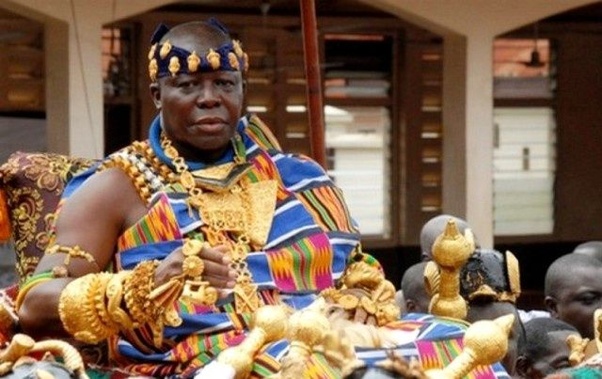The Ashanti Empire (Asante Twi: Asanteman) was an Akan empire and kingdom from 1701 to 1957, in what is now modern-day Ghana. It expanded from Ashanti to include the Brong-Ahafo Region, Central Region, Eastern Region and Western Region of present-day Ghana.
Starting in the late 17th century, the Ashanti king Osei Tutu (c. 1695 – 1717) and his adviser Okomfo Anokye established the Ashanti Kingdom, with the Golden Stool of Asante as a sole unifying symbol. Osei Tutu oversaw a massive Ashanti territorial expansion, building up the army by introducing new organisation and turning a disciplined royal and paramilitary army into an effective fighting machine. In 1701, the Ashanti army conquered Denkyira, giving the Ashanti access to the Gulf of Guinea and the Atlantic Ocean coastal trade with Europeans, notably the Dutch.
The Ashanti Empire fought several wars with neighboring kingdoms and lesser organized tribes such as the Fante. The Ashanti defeated the British Empire’s invasions in the first two of the four Anglo-Ashanti Wars, killing and keeping British army general Sir Charles MacCarthy’s skull as a gold-rimmed drinking cup in 1824. Due to British improvements in weapons technology, burning and looting of the capital Kumasi and final defeat at the fifth Anglo-Ashanti War, the Ashanti empire became part of the Gold Coast colony in January 1, 1902.
The name Asante means “because of war”. The word derives from the Twi words ɔsa meaning “war” and nti meaning “because of”. This name comes from the Asante’s origin as a kingdom created to fight the Denkyira kingdom.
The variant name “Ashanti” comes from British reports that transcribing “Asante” as the British heard it pronounced, as-hanti. The hyphenation was subsequently dropped and the name Ashanti remained, with various spellings including Ashantee common into the early 20th century.
Between the 10th and 12th centuries AD the ethnic Akan people migrated into the forest belt of Southern Ghana and established several Akan states:
Ashanti,
Brong-Ahafo,
Assin-Denkyira-Fante Confederacy-Mankessim Kingdom (present-day Central region)
Akyem-Akwamu-Akuapem-Kwahu (present-day Eastern region and Greater Accra), and
Ahanta-Aowin-Sefwi-Wassa (present-day Western region).
Before the Ashanti Kingdom had contact with Europeans, it had a flourishing trade with other African states due to the Ashanti gold wealth. Trade with European states began after contact with the Portuguese in the 15th century AD. When the gold mines in the Sahel started to play out, the Ashanti Kingdom rose to prominence as the major player in the gold trade. At the height of the Ashanti Kingdom, the Ashanti people became wealthy through the trading of gold mined from their territory.
The Ashanti political organization was originally centered on clans headed by a paramount chief or Amanhene. One particular clan, the Oyoko, settled in the Ashanti’s sub-tropical forest region, establishing a center at Kumasi. The Ashanti became tributaries of another Akan state, Denkyira but in the mid-17th century the Oyoko under Chief Oti Akenten started consolidating the Ashanti clans into a loose confederation against the Denkyira.
The introduction of the Golden Stool (Sika dwa) was a means of centralization under Osei Tutu. According to legend, a meeting of all the clan heads of each of the Ashanti settlements was called just prior to declaring independence from Denkyira. In this meeting the Golden Stool was commanded down from the heavens by Okomfo Anokye, chief-priest or sage advisor to Asantehene Osei Tutu I and floated down from the heavens into the lap of Osei Tutu I. Okomfo Anokye declared the stool to be symbolic of the new Asante Union (the Ashanti Kingdom), and allegiance was sworn to the stool and to Osei Tutu as the Asantehene. The newly declared Ashanti union subsequently waged war against and defeated Denkyira. The stool remains sacred to the Ashanti as it is believed to contain the Sunsum spirit or soul of the Ashanti people
The European contact with the Asante on the Gulf of Guinea coast region of Africa began in the 15th century. This led to trade in gold, ivory, slaves, and other goods with the Portuguese, which gave rise to kingdoms such as the Ashanti. On May 15, 1817 the Englishman Thomas Bowdich entered Kumasi. He remained there for several months, was impressed, and on his return to England wrote a book, Mission from Cape Coast Castle to Ashantee. His praise of the kingdom was disbelieved as it contradicted prevailing prejudices. Joseph Dupuis, the first British consul in Kumasi, arrived on March 23, 1820. Both Bowdich and Dupuis secured a treaty with the Asantehene. But, the governor, Hope Smith, did not meet Ashanti expectations.
Slavery was historically a tradition in the Ashanti Empire, with slaves typically taken as captives from enemies in warfare. The welfare of their slaves varied from being able to acquire wealth and intermarry with the master’s family to being sacrificed in funeral ceremonies. The Ashanti believed that slaves would follow their masters into the afterlife. Slaves could sometimes own other slaves, and could also request a new master if the slave believed he or she was being severely mistreated.
The modern-day Ashanti claim that slaves were seldom abused, and that a person who abused a slave was held in high contempt by society. They defend the “humanity” of Ashanti slavery by noting that those slaves were allowed to marry, and that their children were born free. If a master found a female slave desirable, he might marry her. He preferred such an arrangement to that of a free woman in a conventional marriage, because marriage to an enslaved woman allowed the children to inherit some of the father’s property and status.
This favored arrangement occurred primarily because of what some men considered their conflict with the matrilineal system. Under this kinship system, children were considered born into the mother’s clan and took their status from her family. Generally her eldest brother served as mentor to her children, particularly for the boys. She was protected by her family. Some Ashanti men felt more comfortable taking a slave girl or pawn wife in marriage, as she would have no abusua (older male grandfather, father, uncle or brother) to intercede on her behalf when the couple argued. With an enslaved wife, the master and husband had total control of their children, as she had no kin in the community.
In December 1895, the British left Cape Coast with an expeditionary force. It arrived in Kumasi in January 1896 under the command of Robert Baden-Powell.[24] The Asantehene (king) directed the Ashanti to not resist, as he feared a genocide. Shortly thereafter, Governor William Maxwell arrived in Kumasi as well.
As a final measure of resistance, the remaining Asante court not exiled to the Seychelles mounted an offensive against the British Residents at the Kumasi Fort. The resistance was led by Asante queen Yaa Asantewaa, Queen-Mother of Ejisu. From March 28 to late September 1900, the Asante and British were engaged in what would become known as the War of the Golden Stool. In the end, the British were victorious; they exiled Asantewaa and other Asante leaders to the Seychelles to join Asante King Prempeh I.
In January 1902, Britain finally designated the Ashanti Kingdom as a protectorate. the Ashanti Kingdom was restored to self-rule on 31 January 1935. Asante King Prempeh II was restored in 1957, and the Ashanti Kingdom entered a state union with Ghana on independence from the United Kingdom.
Standing among families was largely political. The royal family typically topped the hierarchy, followed by the families of the chiefs of territorial divisions. In each chiefdom, a particular female line provides the chief. A committee of several men eligible for the post elects the chief.
Education in the Ashanti Kingdom was conducted by Asante and imported scholars and Ashanti people would often attend schools in Europe for their higher education.
Childhood is considered a happy time and children cannot be responsible for their actions. The child is not responsible for their actions until after puberty. A child is harmless and there is no worry for the control of their soul, the original purpose of all funeral rites, so the ritual funerals typically given to the deceased Ashanti are not as lavish for the children.
The Ashanti adored twins when they were born within the royal family because they were seen as a sign of impending fortune. Ordinarily, boy twins joined the army and twin girls potential wives of the King. If the twins are a boy and girl, no particular career awaits them. Women who bear triplets are greatly honored because three is regarded as a lucky number. Special rituals ensue for the third, sixth, and ninth child. The fifth child (unlucky five) can expect misfortune. Families with many children are well respected and barren women scoffed at.
The Ashanti held puberty rites only for females. Fathers instruct their sons without public observance. The privacy of boys was respected in the Ashanti kingdom. As menstruation approaches, a girl goes to her mother’s house. When the girl’s menstruation is disclosed, the mother announces the good news in the village beating an iron hoe with a stone. Old women come out and sing Bara (menstrual) songs.
Menstruating women suffered numerous restrictions. The Ashanti viewed them as ritually unclean. They did not cook for men, nor did they eat any food cooked for a man. If a menstruating woman entered the ancestral stool (shrine) house, she was arrested, and the punishment could result in death. If this punishment is not exacted, the Ashanti believe, the ghost of the ancestors would strangle the chief. Menstruating women lived in special houses during their periods as they were forbidden to cross the threshold of men’s houses. They swore no oaths and no oaths were sworn for or against them. They did not participate in any of the ceremonial observances and did not visit any sacred places.
Sickness and death were major events in the kingdom. The ordinary herbalist divined the supernatural cause of the illness and treated it with herbal medicines.
People loathed being alone for long without someone available to perform this rite before the sick collapsed. The family dressed the deceased in their best clothes, and adorned them with packets of gold dust (money for the after-life), ornaments, and food for the journey “up the hill”. The body was normally buried within 24 hours. Until that time the funeral party engage in dancing, drumming, shooting of guns, all accompanied by the wailing of relatives. This was done because the Ashanti typically believed that death was not something to be sad about, but rather a part of life. As the Ashanti believed in an after-life, families felt they would be reunited with their ancestors upon death. Funeral rites for the death of a king involved the whole kingdom and were a much more elaborate affair.
The greatest and most frequent ceremonies of the Ashanti recalled the spirits of departed rulers with an offering of food and drink, asking their favor for the common good, called the Adae. The day before the Adae, Akan drums broadcast the approaching ceremonies. The stool treasurer gathers sheep and liquor that will be offered. The chief priest officiates the Adae in the stool house where the ancestors came. The priest offers each food and a beverage. The public ceremony occurs outdoors, where all the people joined the dancing. Minstrels chant ritual phrases; the talking drums extol the chief and the ancestors in traditional phrases. The Odwera, the other large ceremony, occurs in September and typically lasted for a week or two.
It is a time of cleansing of sin from society the defilement, and for the purification of shrines of ancestors and the gods. After the sacrifice and feast of a black hen—of which both the living and the dead share—a new year begins in which all are clean, strong, and healthy
Today, the Ashanti Kingdom survives as a protected, sub-national traditional state in union with the Republic of Ghana. The Ashanti Kingdom is the home to Lake Bosumtwi, Ghana’s only natural lake. The state’s current economic revenue is derived mainly from trading in gold bars, cocoa, kola nuts and agriculture.
REFERENCE
1. Available online at, https://en.m.wikipedia.org/wiki/Ashanti_Empire.





